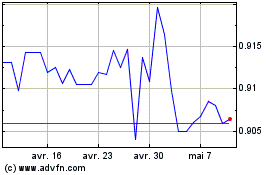U.S. Dollar Strengthens As Inflation Picks Up, Jobless Claims Fall Unexpectedly
14 Septembre 2017 - 11:36AM
RTTF2
The U.S. dollar climbed against its most major opponents in the
European session on Thursday, as an improvement in U.S. consumer
price inflation for August coupled with an unexpected drop in
weekly jobless claims raised hopes for further rate hike by the Fed
later this year.
Data from the Labor Department showed that U.S. consumer prices
increased slightly more anticipated in August led by a sharp jump
in energy prices.
The Labor Department said its consumer price index climbed by
0.4 percent in August after inching up by 0.1 percent in July.
Economists had expected consumer prices to rise by 0.3 percent.
Excluding food and energy prices, the core consumer price index
rose by 0.2 percent in August following a 0.1 percent uptick in the
previous month. The increase in core prices matched economist
estimates.
Separate data showed an unexpected pullback in initial jobless
claims in the week ended September 9, following a sharp jump in
first-time claims for U.S. unemployment benefits in the previous
week.
The report said initial jobless claims fell to 284,000, a
decrease of 14,000 from the previous week's unrevised level of
298,000. The drop surprised economists, who had expected jobless
claims to inch up to 300,000.
The greenback held steady against its major rivals in the Asian
session, with the exception of the euro.
The greenback advanced to a new 4-week high of 0.9705 against
the Swiss franc, from a low of 0.9618 hit at 3:30 am ET. The
greenback-franc pair is likely to find resistance around the 0.98
region.
The Swiss National Bank maintained its expansionary monetary
policy and upgraded its inflation projections.
The interest rate on sight deposits at the SNB was retained at
-0.75 percent and the target range for the three-month Libor was
kept unchanged between -1.25 percent and -0.25 percent.
The greenback climbed to 111.04 against the Japanese yen, its
strongest since August 4. On the upside, 112.00 is possibly seen as
the next resistance for the greenback-yen pair.
The latest figures from the Ministry of Economy, Trade and
Industry showed that Japan's industrial production declined as
initially estimated in July
Industrial production dropped a seasonally adjusted 0.8 percent
month-over-month in July, reversing a 2.2 percent rise in June.
That was in line with the flash data published on August 31.
The greenback reversed from an early low of against the euro,
rising to a 2-week high of 1.1838. Continuation of the greenback's
uptrend may see it challenging resistance around the 1.17 mark.
The greenback strengthened to a 9-day high of 0.7956 against the
aussie, weekly highs of 1.2239 against the loonie and 0.7184
against the kiwi, from its early lows of 0.8016, 1.2160 and 0.7262,
respectively. If the greenback extends rise, 0.77, 0.70 and 1.25
are likely seen as its next resistance levels against the aussie,
the kiwi and the loonie, respectively.
On the flip side, the greenback weakened to more than a 1-year
low of 1.3372 against the pound, off its early 6-day high of
1.3148. The next possible support for the greenback is seen around
the 1.35 region.
The Bank of England retained its record low interest rate again
in a split vote as two members sought a rate hike.
The Monetary Policy Committee voted 7-2 to hold the interest
rate at 0.25 percent. But all nine members voted to maintain the
quantitative easing at GBP 435 billion.
US Dollar vs CHF (FX:USDCHF)
Graphique Historique de la Devise
De Mar 2024 à Avr 2024

US Dollar vs CHF (FX:USDCHF)
Graphique Historique de la Devise
De Avr 2023 à Avr 2024
